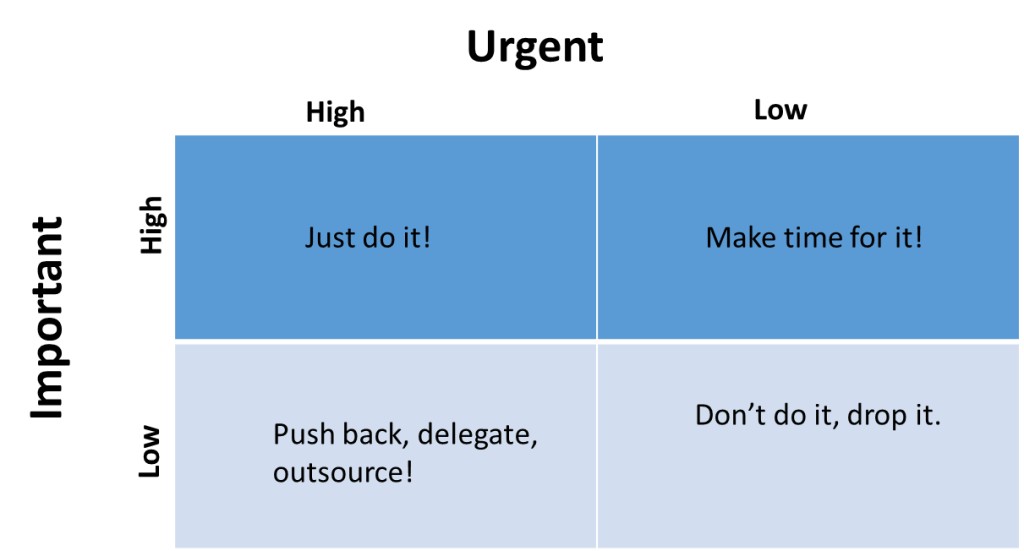A few years ago, after becoming an entrepreneur, I became overwhelmed with the choices available to me. prioritisation? What prioritisation? I no longer had a boss, I could do anything I wanted!
This idea became simultaneously satisfying and paralyzing.
After all the buck stopped with me, every time. I was responsible for everything, and I loved it. I could do anything I wanted, and that was the problem – I thought “I can do this…I can do this and that and that and this.”
I was asking “what can I do?”, but the real question was, “what should I do?”. I’d set my goal and I was off on the adventure with my best intentions. After all, we all start our goals with the best intentions. If we didn’t, we wouldn’t have chosen the goal in the first place. Right?
However, it is way too easy to lose track of the goal posts, and find yourself drowning in the daily drudgery of unimportant tasks.
Where, EVERYTHING must be done RIGHT NOW.
Everything becomes the top priority. You start something and then then next moment you’re distracted by the next “urgent” task at the expense of the last.
How do you combat this? I had to get serious about my priorities, and forget the unimportant. Here’s the prioritisation tactics that what worked for me.
Prioritisation – Doing important Things, Not Urgent Ones.
Before we do anything else, stop reading your email, close Instagram and…don’t you dare hit reply on that “urgent” email.
1. Create a Short To-do List
Write down the top 5 things that are causing you the most stress. Then assign a prioritisation rating of 1-5. I assess this by asking myself these questions “if this task was the only thing I accomplished today, would I be satisfied with my day?” & “If I complete this task, will it make other tasks easier to complete?”
Then In application: Though out the day, I check in to ensure I’m working on the right thing – Why am I working on a priority 4 when there’s a priority 1 on my list?
2. Create & Use a Not-to-do List.
This is a list of things that you shouldn’t do before/after a certain time or even things you shouldn’t do ever.
For me the not-to-do list looks like this:
- Don’t check social media and emails before a certain time OR until I’ve completed a certain task.
- I find that on mornings where I break this rule (yep, I’m not perfect.) my mind becomes an “Alice” and wanders too far down the proverbial rabbit hole. i.e. I get so distracted that half my day is gone before I’ve achieved anything of worth. This one is the most effective for me personally.
- I don’t answer phone calls when I’m in the middle of something.
- In my experience even a 3 min phone conversation can derail your intentions for hours.
- If I’ve done this to you, now you know my secret #sorryNotSorry.
- If it’s important most people will leave a message anyway.
3. Start Your Day with a Bang
Do the most important thing first, I use the above to-do list and not-to-do list to ensure I don’t get distracted. When you accomplish something big it adds fuel to the productivity fire and sets you up to win. Prioritisation for the win!
4. Chunking and not Multitasking
It may seem counterintuitive to popular productivity philosophies of the day, but for me this is when I’m at my most productive.
Every time you change task you lose time as it tasks you brain time to regroup. Have you ever said “Now, where was I?”
Essentially, I try not to jump from task to task. Instead, I chunk like tasks together. If I’m writing an article, that’s all I’ll do until I’m finished. I try not to jump from writing, to emails, to planning, to etc.
Example: Do you really need to check your email constantly? Would twice a day work? This can be a hard habit to break, I find that I’ve got to actually close my email – that little red notification dot is just too much for me to resist.
5. Use the Urgent & Important matrix.
Basically, as it turns out, urgent & unimportant things are the time sappers in our day (like a unrealistic deadline or an unnecessarily demanding client). On the flipside, un-urgent, VERY important things are the things we put off (like exercise or network building). Low importance, low urgency? Drop it. Colour coding last year’s files is not going to make you a better business person.
I use this prioritisation matrix, when I’m struggling to determine importance and urgency. It’s pretty simple really, classify a task and follow the prompts in the squares.
6. Let Bad Things Happen – Sometimes
To be successful at prioritisation, you’ve also got to let bad things have to happen sometimes. I’m not talking about catastrophic things, but small “bad” things. E.g. miss that call, pay a late fee.
It might be annoying but I’ve found that expense of these “bad” things is a lot less than what they cost in terms of productivity and attention loss.
Buyer Beware: A Prioritised Purposeless Goal = A Bad Idea.
The art of prioritisation is great, but alone will only get you so far. A goal/dream unbacked by purpose, will soon fade into the obscurity. How to Put Purpose Behind Your Goals.
The purpose behind any goal could quite possible be THE most important part.
A lot of the above I adopted and adapted after reading Tim Ferris’s Book, The Four Hour Work Week – Credit where credit is due, you know.


